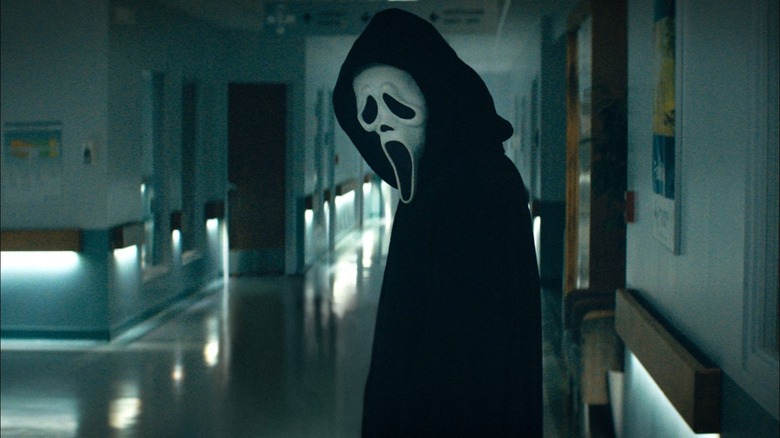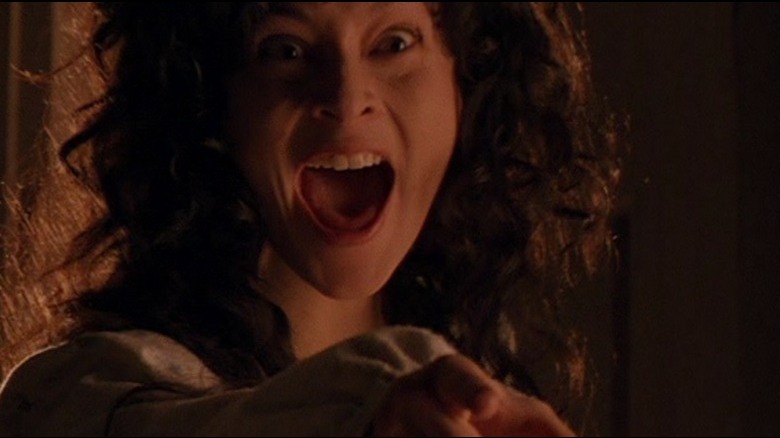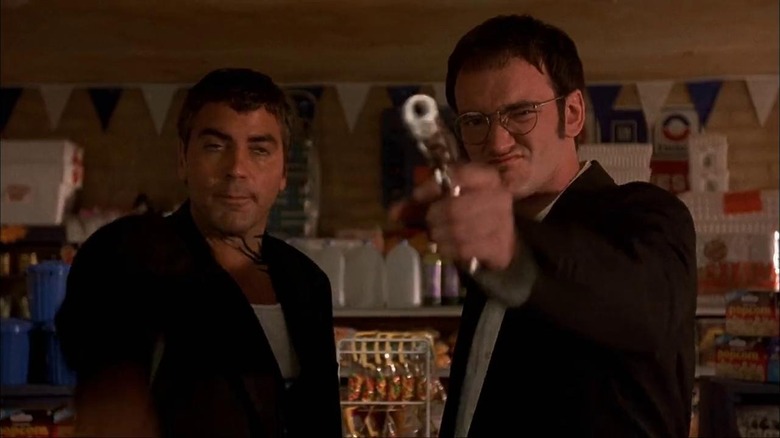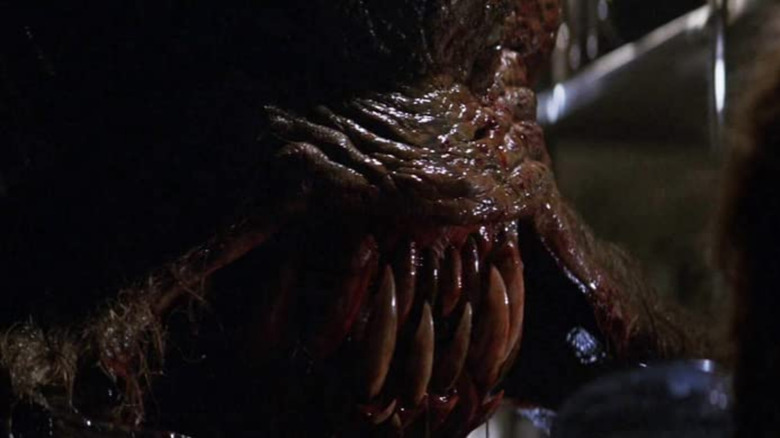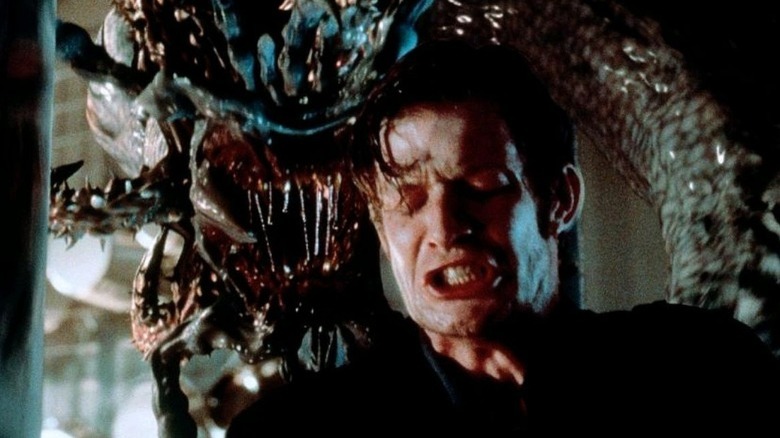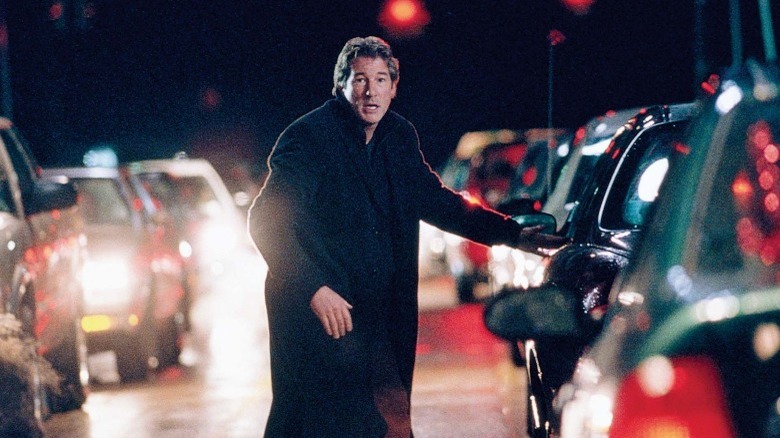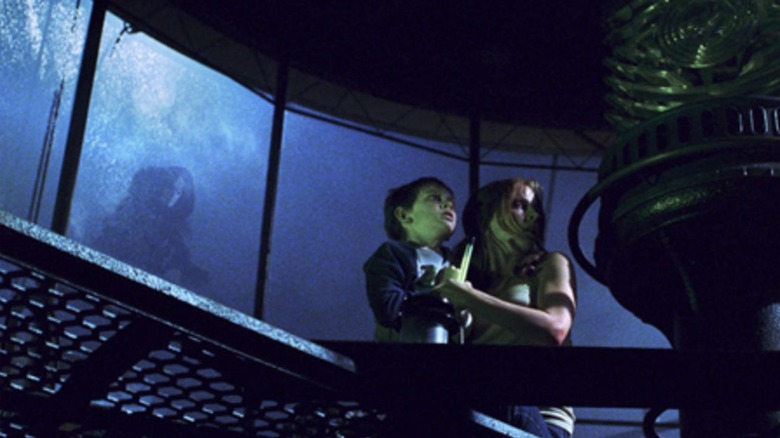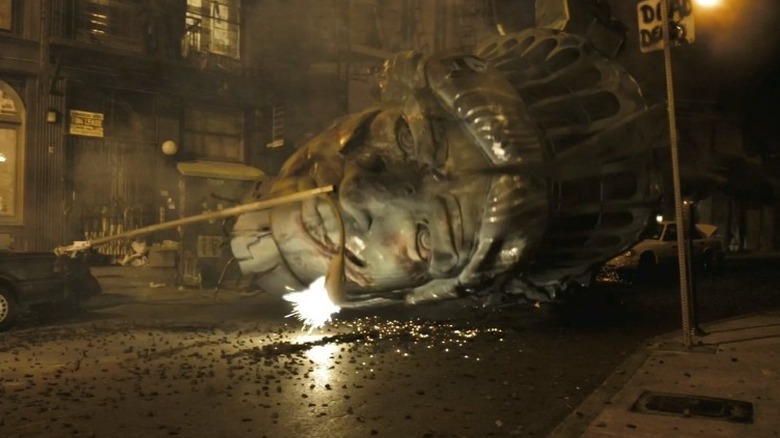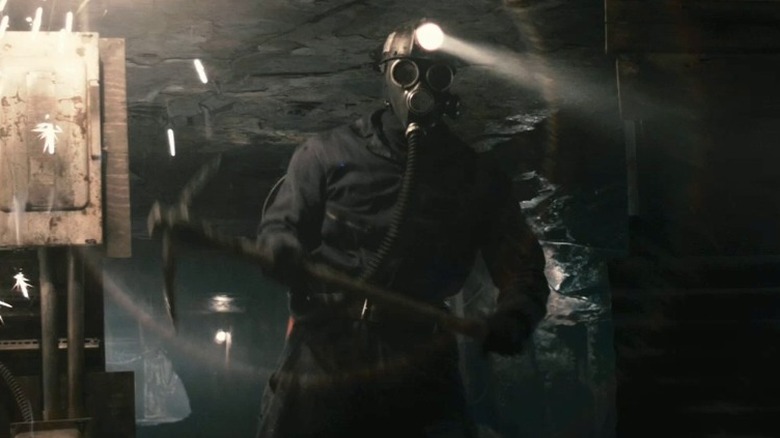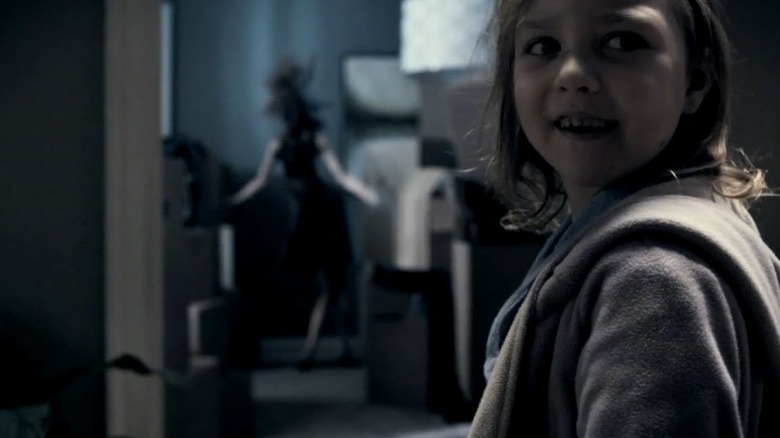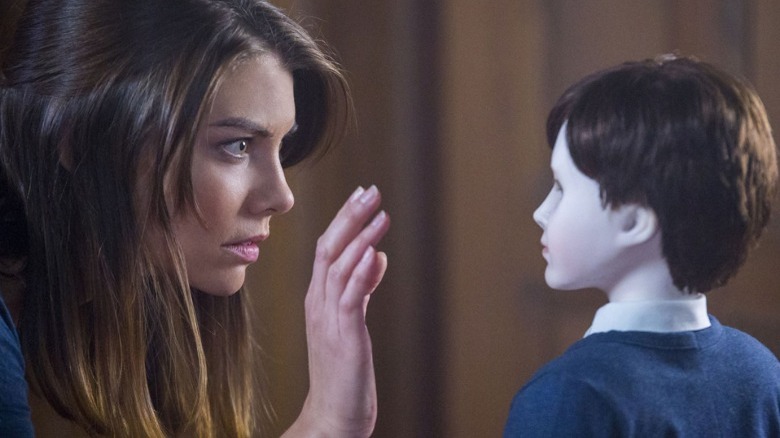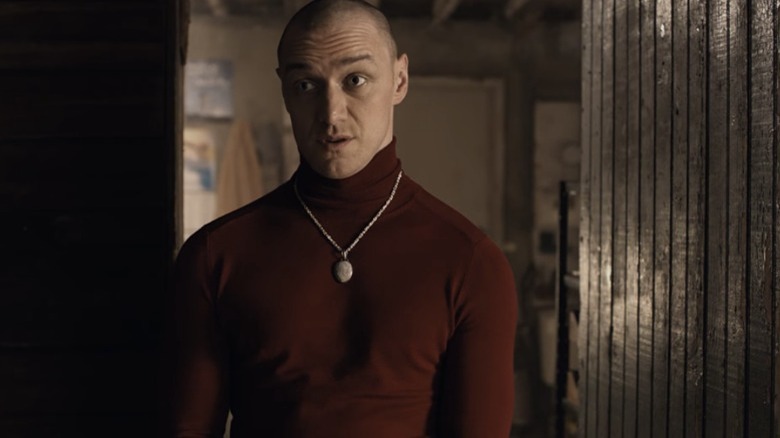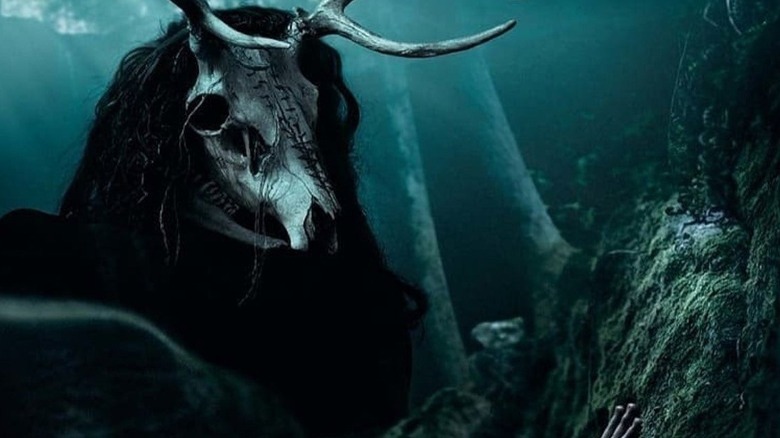The 12 Best January Horror Releases Of All Time, Ranked
January horror releases have a bad rap. The reputation is undeserved, though not entirely unfounded. According to Business Insider, there's a host of factors that have resulted in January being the colloquial "dumping month" for studio releases. Fear of competing with awards contenders, holiday fatigue, and even inclement winter weather are several reasons that studios opt to "dump" less-than-stellar releases in January, hoping to recoup something in a month with little to offer.
Yet, the trend is not resolute, and despite some truly horrific offerings, January has had its fair share of hits both critically and commercially, including the original "Taken" and both "Paddington" movies. Additionally, the present landscape of film releases has had a profound impact. With streaming and PVOD offerings, more movies are available on more platforms than ever before, and conventional wisdom is growing increasingly obsolete. January is no longer a certified death sentence, despite what history says. With "Scream" poised to release this week, it's high time to revisit 12 of not just the best January releases ever, but specifically horror releases. Horror, forever the intractable underdog, has bucked the trend time and time again.
12. Body Snatchers (1994)
Abel Ferrara's "Body Snatchers" is a curious beast. A neo-noir maestro and longtime independent filmmaker, Ferrara seemed an odd choice to helm a mid-budget horror remake. Warner Bros. likely realized this, releasing "Body Snatchers" in just dozens of theaters in January 1994, a few months after its 1993 Cannes premiere. Simultaneously austere and conventional, it's a movie at odds with itself, but that doesn't mean there isn't something there worth seeing.
On the performance end, Meg Tilly is suitably chilling as one of the first pod people, and Gabrielle Anwar as Marti, Tilly's stepdaughter, makes for a reasonable final girl. While the climactic action feels like Ferrara satisfying studio expectations and nothing else (a sentiment that would also plague 2007's "The Invasion," another remake of Jack Finney's classic novel), some of the preceding material is disgustingly chilling. Chief among them is a mid-movie scene where a body falls from the ceiling while Marti takes a bath. From there, it's close calls and genuine tension as the frenetic Marti tries to escape being taken over by the pods. It's not the greatest remake — that honor still belongs to the 1978 version — but it tries enough new to stand out.
11. From Dusk till Dawn (1996)
"From Dusk Till Dawn" rocks, and admittedly it even had a smattering of worthwhile sequels released direct-to-video. With video games and a television series, "From Dusk Till Dawn" is a bonafide media franchise, and, well, it deserves it. Directed by Robert Rodriguez and written by Quentin Tarantino (that alone should sell you), it stars George Clooney and Tarantino as two criminals who cross into Mexico with a family they've taken hostage for safe passage. Soon, though, they are trapped in a saloon overrun by vampires and find themselves in a fight for their lives.
It's classic Rodriguez and Tarantino, two of the best practitioners of contemporary grindhouse pulp. Though at times style overwhelms substance, the film adroitly encapsulates why both filmmakers are so fond of drive-in throwbacks. A fun, violent, stylish, frequently funny, and well-made genre feature, it never asks too much of the audience. With plenty of verve and guts, this is one of January's best horror releases.
10. The Relic (1997)
Peter Hyams' "The Relic" released nationwide in January 1997. Based on the novel "Relic" by Douglas Preston and co-written by none other than "The Slumber Party Massacre" scribe Amy Holden Jones, "The Relic" is the simple story of a monster in a museum. Though the novel is considerably more scientific and brooding, the movie adaptation is a classic giant monster fiasco.
Penelope Ann Miller stars as a biologist in a Chicago Museum endeavoring to defeat a South American reptilian monster that, naturally, begins killing museum workers and fundraising guests alike. Released at the peak of the late-'90s giant monster trend (see: "Deep Blue Sea"), "The Relic" is an unabashed B-movie with a blockbuster budget, from an era where Hollywood was willing to throw $60 million at a monster flick. Those monster effects are stellar, the gore certifiably R-rated (there are plenty of beheadings), and the clip never too sluggish for a movie about a killer lizard. It's criminally underseen and bucks the trend of lazy January releases.
9. Deep Rising (1998)
"Deep Rising," dare I say it, rises above the pack of similarly themed aquatic horror fables. As directed by Stephen Sommers and starring Treat Williams and Famke Janssen, it's a bonanza of oceanside gore and monstrous mayhem. A group of mercenaries along with luxury cruise guests collide when the Argonautica, a new luxury cruise line, has its coms disabled and is left floating in the middle of the ocean. Soon thereafter, an unknown creature rises from the depths, using its monstrous tentacles to kill almost everyone on board.
Soon the mercenaries board and meet up with the remaining survivors, and from there it's a simple mission of "destroy the monster, escape the boat." Though never especially scary — Sommers is wisely aware of the movie's B-movie roots in a post-"Scream" world — it's a genuine blast from start to finish. The monster itself, the Octalus, is akin to a contemporary Kraken. It's long, gooey, big, and looks like a hellish octopus, hence the name. One of the best water-bound '90s movies there is.
8. The Mothman Prophecies (2002)
God bless "The Mothman Prophecies." In retrospect, it feels like the product of a bygone era, no different than the titular monster himself. There was a time when studios, other than A24, released brooding, atmospheric horror out into the world, profits be damned. Sure, "The Mothman Prophecies" has two bonafide stars in Laura Linney and Richard Gere, appearing alongside each other for the first time since "Primal Fear," but nothing about it screamed mainstream success.
Other than a "Final Destination" riff in its bloated set-piece finale, "The Mothman Prophecies" is deliciously patient. Gere is drawn into the mystery after his wife, an underutilized Debra Messing, passes away and he discovers drawings of a terrifying moth-like creature. Years later, he meets Linney's police officer, and the two bond over strange phone calls, cryptic warnings, and reports of mothman sightings in and around Point Pleasant, West Virginia. It's terrifying in just how unknowable it is. "The Mothman Prophecies" never resorts to "gotcha" chills or conventional tactics. It's a deliberately-paced chiller, one whose impact is likely more profound than it's been given credit for.
7. Darkness Falls (2003)
"Darkness Falls" is, among all entries here, the most criminally underrated. It should seriously be a crime against cinema that "Darkness Falls" isn't referenced more often than it is. Yes, it's painfully short (its closing credits run 11 minutes to meet feature length), is clearly the product of a hatchet-job to reduce it to a PG-13 rating (its original poster bore an "R"), and flirts with greatness without ever truly achieving it. It's also genuinely scary, and that counts for a lot.
The story of a crazed tooth fairy named Matilda going on a killing spree in the titular town of Darkness Falls, the film adroitly uses both light and dark to maximum effect as said tooth fairy can only survive in darkness. The introductory sequence alone is a top five for the decade in terms of sheer terror, as a young boy named Kyle (Joshua Anderson, playing the younger version of lead Chaney Kley's character) is terrorized in his childhood home after losing a tooth. There's an image of him crouched in the tub with the lights on and right above is Matilda, screeching and hollering into the night, patiently waiting for the lights to go off. It's an image that paralyzed an entire generation of young horror fans whose parents unwisely rented it from the local video store. With an awesome central monster and scares that hold up, "Darkness Falls" represents some of the best of what early aughts horror had to offer.
6. Cloverfield (2008)
It's freaking "Cloverfield," my man. Released in January 2008, fan reception for Matt Reeves' found footage monster movie was undoubtedly hurt by its truly stellar marketing. No different than "The Blair Witch Project" a decade prior, the movie had no chance of standing up to cryptic teasers, a reluctance to release a title, and fervent online speculation which had everyone wondering what the hell "Cloverfield" was even about prior to release.
In the end, it was simply a giant monster movie, one fortunately or unfortunately (depending on who you ask) rendered in found footage, shaky-cam style. Glimpses of the massive monster are limited, and while the full scope is effective it's less about Clovie himself and more about the bundle of semi-irritating young adults he's picking off in the streets of New York City. While the movie itself (and the franchise writ large) remain polarizing, it's hard to overstate just how profound an impact "Cloverfield" had on the industry. It revolutionized found footage (again) and changed film marketing for the better, at least for a time. The "less is more" approach remains controversial, but "Cloverfield" is a contemporary classic for a reason.
5. My Bloody Valentine 3D (2009)
The 3D era was strange. While some filmmakers are fully committed to exploring its possibilities, the regularity of theatrical 3D releases is a relic of the past. Curiously, the horror genre itself was a frequent contributor (or sinner for anyone, myself included, with eyeglasses) to the 3D trend. Beholden to the William Castle theatrics of yesteryear, 3D was a gimmick that rarely, if ever, panned out. That being said, while "My Bloody Valentine 3D" isn't great in 3D — unless you want pickaxes and severed limbs thrown in your face — the regular version is one of this century's best slashers.
A remake of the 1981 Canadian original, "My Bloody Valentine 3D" turns the exploitation dial to 11. There's more nudity, gore, and expletives in a single frame here than most modern horror movies have during their entire duration. The story of a deceased miner ostensibly returned from the dead, Harry Warden (or someone disguised as him) starts hacking and slashing the residents of Harmony, West Virginia 10 years after the original massacre. It's a post-"Scream" whodunnit, knowingly self-aware and excessive where it matters most. It's fun, frenetic, and bloody engaging.
4. Mama (2013)
"Mama" was perhaps the most Guillermo del Toro movie ever not directed by del Toro. It makes sense since the Oscar-winner served as an executive producer, assisting director Andy Muschietti in expanding his original short about a monstrous ghost mama in the woods. It's a genuinely moving fairy tale with horror elements, scary where it counts, but deeply felt and empathetic in a way that studio horror tends to reject.
Jessica Chastain stars as Annabel, a young rockstar consigned to care for her boyfriend's two nieces after they're found living feral in the woods, their parents murdered years prior. Of course, everyone (including psychologist Dr. Gerald Dreyfuss played by Daniel Kash) wonders how these two young girls survived for so long on their own. Turns out it was because of Mama, played by Hollywood's go-to monster man Javier Botet doing what he does best. Muschietti's style and verve would later serve him well with the remake of Stephen King's "It," and "Mama" is the perfect calling card for his style there. January has rarely been this creepy.
3. The Boy (2016)
"The Boy" liberally borrows from underrated New Zealand horror-comedy "Housebound," and for genre aficionados who saw Gerard Johnstone's feature first, a lot of it feels like déjà vu. Lauren Cohan, taking a break from "The Walking Dead," stars as Greta Evans, an American woman who travels to the United Kingdom to escape her abusive ex while working as a nanny for the Heelshires. When she arrives, however, she discovers they don't actually have a son ... they have a doll. Brahms is a creepy, life-size porcelain doll, one the Heelshire's insist Greta treat as a real boy while they're away.
Though she initially rebuffs the idea, she is soon seduced by the doll, in no small part because she starts to wonder whether Brahms really is alive. There are strange noises at night, he seems to move around the house on his own, and soon enough she suspects Brahms is actually talking to her. William Brent Bell's PG-13 horror-lite entrée is suitably diverting. The acting is strong, some of the scares work, and it has a polished Hammer-style gothic look to it. It's not the greatest January output, but high concept horror often disappoints. "The Boy" is that rare exception that delivers exactly what it promised, and sometimes that's enough. You can skip the sequel, though.
2. Split (2017)
Writer/director M. Night Shyamalan's 2015 film "The Visit" was an unqualified success. After a series of flops ("After Earth," anyone), "The Visit" marked a return to form, exactly the kind of accessible gothic lark Shyamalan had once been famous for. Grossing $98 million against a meager $9 million budget, the stage was set for classic, early-aughts Shyamalan, with "Split" being his 2016 follow-up.
It follows James McAvoy's Kevin Wendell Crumb, a man suffering from dissociative identity disorder who kidnaps three young girls at the mall, including clear final girl Casey Cooke (a sensational Anya Taylor-Joy). "Split" has so much going for it, not the least of which is the interplay between Taylor-Joy and McAvoy. Both are at the top of their game, elevating what could have been a conventional psycho-thriller to something akin to genuine art. McAvoy is especially adept at transitioning between disparate identities, including "The Beast," his hyper-violent/strong identity, and while it isn't an especially tactful portrayal of dissociative identity disorder, it's thoroughly tense. Plus, it has one of Shyamalan's best twists ever. Made clear in the final scene, "Split" is a sequel to his seminal 2000 film "Unbreakable."
1. Wrong Turn (2021)
"Wrong Turn's" reboot was controversial from the start. Beyond releasing theatrically for just one night in the midst of a pandemic (though it curiously managed to gross a respectable $4.5 million), it did away with the series' central conceit: monstrous cannibals. In its place is the "Foundation," a post-war mountainous society which a group of six city-dwellers run afoul of while hiking the Appalachian Trail. They're no less violent than the "Wrong Turn" cannibals, but they are considerably more political, with 2021's "Wrong Turn" grappling with its longstanding portrayal of rural mountain folk.
While it's arguably a "Wrong Turn" movie in name only, it still does a lot right. The set-pieces are strong, the commentary intermittently compelling, and the acting solid across the board. Were its release handled differently, there's a solid chance it would have revitalized the franchise, inciting new directions for horror's favorite cannibals. As it stands, though, it's a January release that took big risks, most of which paid dividends. That's a success in my book.
